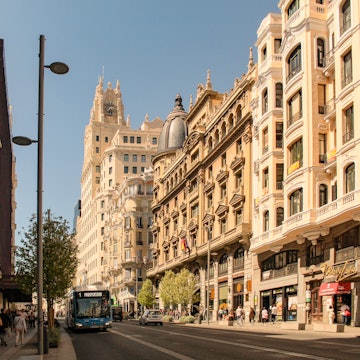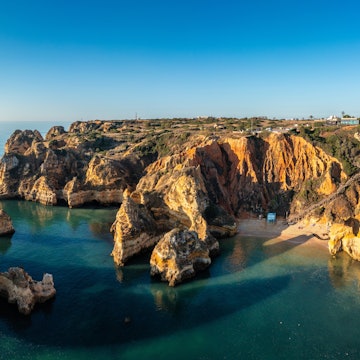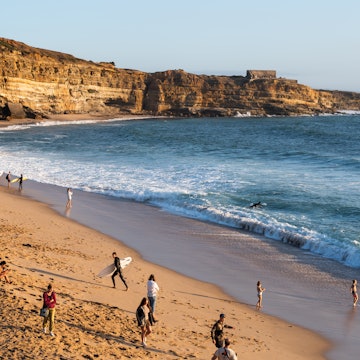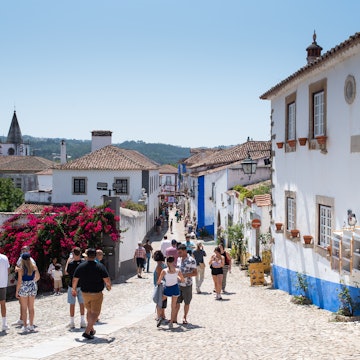

Portugal is filled with perfect off-the-beaten-path destinations to enjoy © Mint Images / Getty Images
Portugal aims to welcome visitors with open post-lockdown arms this summer, with plans in the pipeline for an “air bridge” that will hopefully mean quarantine-free travel come July.
Forget the package-tour resorts, the real appeal of the country lies in its wild, thrillingly remote places: from granite mountains where you can hike from one sun-bleached village to the next, to raw, rugged coastlines shaped by the tempestuous Atlantic, here are a few off-the-beaten-path Portugal destinations.
Parque Nacional da Peneda-Gerês
If you want off-grid isolation, this 703-sq-km national park, tucked away in Portugal’s far north, is the stuff of dreams. The landscapes are phenomenal, with granite mountains rising above oak and pine forests, mountain streams carving up valleys and eyrie-like villages and espigueiros (granaries built on stilts) perching atop hillsides overlooking terraced fields. With so much unperturbed nature here, ibex, deer, wild horses and Iberian wolves find plenty of hiding places.
See it
It’s easy to give civilization the slip, especially in the lesser-visited north of the park, accessed from the Lamas de Mouro gateway. It’s a terrific place for hiking, with glacially eroded mountains rolling to wildflower prairies, waterfalls dropping to deep ravines, and wild horses grazing the savannah. Peneda, with its domed peak, pilgrimage church and ruined Moorish castle, makes a great base for the Trilho Castrejo, a 17km (11 miles), seven-hour loop striking out along some of the park’s oldest footpaths.

Alto Douro
Porto is but a cork pop away from one of off-the-beaten-path Portugal’s most ravishingly beautiful landscapes – Alto Douro. Unfurling along the banks of the Rio Douro from Peso da Régua, this region is a rolling tapestry of steeply sloping terraces, delicately embroidered with vines. One of the world’s oldest demarcated wine regions, this Unesco Heritage site looks back on 2000 years of winemaking prowess, with beefy reds, mineral-fresh whites and fine ports that are still much feted today. Many can be sampled at the whitewashed quintas (wine estates) that stand sentinel above the calm waters of the river.
See it
Pinch-yourself-pretty Pinhão is a great base for wine tastings and embarking on the helter-skelter drive along the N313-2 to Miradouro São Leonardo de Galafura, which commands dress-circle views of the vines and river.
How to get off-the-beaten-path in Porto
Estremadura
Though just north of Lisbon, the Estremadura is often eclipsed in favor of coastlines closer to the capital or the Algarve’s beaches down south. But this unsung region, reaching from the Rio Tejo to the wave-hammered Atlantic Ocean, is ripe for discovery. There’s a pinch here of everything that makes Portugal special: white-sand beaches, vast pine forests and vineyards, castles, monasteries and historic villages. And crowds are few.
See it
Peniche is all about the surf, but if it’s too lively, take a boat across to the Reserva Natural da Berlenga. Rock formations and caves engrave the craggy coastline of this island nature reserve, while offshore shipwrecks lure divers into the deep-blue depths. Óbidos, a half-hour drive inland, is one of Portugal’s loveliest towns, its bone-white, red-roofed houses are ringed by intact medieval walls and crowned by a Moorish castle where you can stay the night.

Parque Natural da Serra da Estrela
With trails threading into the wild blue yonder of the country’s highest mountains, this is off-the-beaten-path Portugal at its most rugged and spectacular. You’ll need your own wheels to tackle the tortuous, hairpin bend-riddled drives that deposit you at the foot of wind-battered crags, highland pastures and sheer-sided valleys wooded with sweet chestnut and holm oak. Unfurling over 888 sq km (343 sq miles), the Serra da Estrela Natural Park is the country’s largest and oldest protected space. It tops out at 1993m (6539ft) Torre, mainland Portugal’s highest point.
See it
A pretty gateway is Manteigas, right in the heart of the park, with sulfur-rich hot springs and walking trails that twist past terraced meadows and shepherd’s huts. Or venture further west to Seia for rural lodgings and a visit to the Centro de Interpretacão da Serra da Estrela, giving the inside scoop on exploring the park.
The Serra da Estrela: exploring Portugal's "star mountain"
West coast Algarve
Beyond the big resorts on the Algarve’s south coast, the west is where you’ll find true wilderness and a proper get-away-from-it-all feel. Plot a road trip to remote coves, dune-flanked nature reserves and sickle-shaped beaches of butterscotch sand that bear the full brunt of the Atlantic. Much of the coast forms part of the Parque Natural do Sudoeste Alentejano e Costa Vicentina, a nature reserve protecting coastal wetlands, marshes, rock formations and cliffs impressively eroded by wind and water.
See it
Launch your south-north drive at the lonely headland of Cabo de São Vicente, where razor-edge cliffs mark Europe’s most southwesterly point. From here, inch slowly up the coast, stopping at Praia do Castelejo, where fishers cast into the spindrift of the roaring Atlantic, the chilled hippy surf town of Carrapateira and nearby Praia do Amado. Dunes fizz into big rollers at lagoon-side Praia da Bordeira, while cliffs plunge to a generous curve of golden sand at Praia da Arrifana, just north. The low-key town of Odeceixe and Moorish castle-topped Aljezur are enticing stop-overs
Why the Algarve defied my expectations

Alto Alentejo
A perfect place to escape, the Alentejo takes up a hefty chunk of the country with its gold-brushed plains, big skies, cork oak forests and gently rolling hills ribbed with vines and olive groves. A self-devised trip wings you from one pretty marble town and medieval city to the next in this quietly lovely region. And if more temptation is needed, you’ll find it in the food: the Alentejo dishes up Portugal’s finest produce: from smoky porco preto (black pork) to seafood, almonds, olive oil and full-bodied red wines.
See it
A middle-of-nowhere agriturismo, or farm stay, is the way to go, with the galo (cockerel) as your wake-up call. While the charms of ring-walled Évora and its Templo Romano are well-publicized, they are just a prelude to the rest of the region. Factor in time to see the astonishing castle-topped hill town of Monsaraz, fortified, medina-like Elvas, and dazzlingly white, precipitously perched villages like Castelo de Vide and Marvão.
The Alentejo: dining in Portugal's tradition
Trás-os-Montes
Life ticks on at a deliciously languid, old-fashioned pace in the Trás-os-Montes, a rural region that ripples east of Porto, bookends the Alto Douro and nudges up against Spain. The joy of being here goes beyond map and app: explore stuck-in-time villages embosomed in vineyards, olive groves and almond orchards. From the silent, heather-brushed hills of the north to the sheer-sided canyons of the arid east, this outdoorsy region will have you longing to hike, bike, camp and wild swim.
See it
The university town of Vila Real is a cultured base, worth a stop for a feast of baroque architecture and rosé wine at Casa de Mateus. Just north is the Parque Natural do Alvão, with its rocky highlands, waterfalls and schist villages like slate-roofed Ermelo and highest-of-the-high Lamas de Ôlo. Wilder still, in the region’s northeast, is the 750-sq-km Parque Natural de Montesinho, where you’ll have the trails all to your wandering self.
You might also like:
Virtual vacation: Portugal
7 sensational things to do in Madeira
Why adventure lovers should head to northern Portugal














